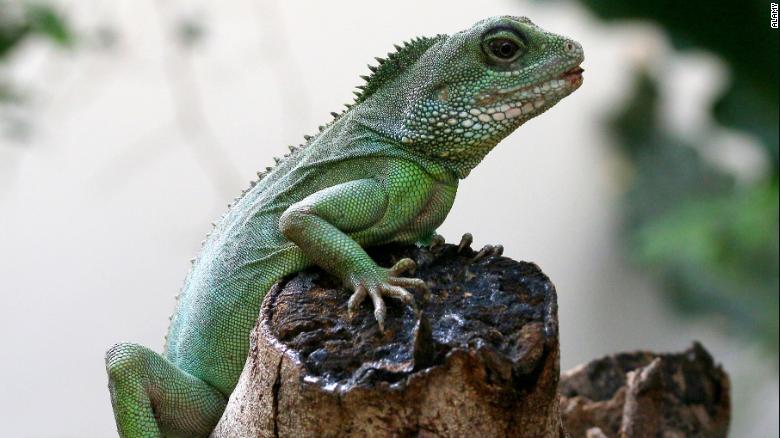(CNN) (The Conversation) – An Asian water dragon hatched from an egg at the Smithsonian National Zoo, and its keepers were shocked. Why? His mother had never been with a male water dragon. Through genetic testing, zoo scientists discovered that the newborn female, born on August 24, 2016, had been produced through a reproductive mode called parthenogenesis.
Parthenogenesis is a Greek word that means “creation of virgins,” but it specifically refers to female asexual reproduction. While many people may assume that this behavior is the domain of science fiction or religious texts, parthenogenesis is surprisingly common throughout the tree of life and It is found in a variety of organisms, including plants, insects, fish, reptiles, and even birds. Because mammals, including humans, require certain genes to come from sperm, mammals are incapable of parthenogenesis.
Read also: From snakes to armadillos: 113 rescued animals released in Colombia
Creating offspring without sperm
Sexual reproduction involves a female and a male, each contributing genetic material in the form of eggs or sperm, to create a unique offspring. The vast majority of animal species reproduce sexually, but females of some species are capable of producing eggs that they contain all the genetic material necessary for reproduction.
The females of these species, which include some wasps, crustaceans, and lizards, reproduce only through parthenogenesis and they are called obligate parthenogens.
More species experience spontaneous parthenogenesis, best documented in animals kept in zoological settings, such as the Asian water dragon at the National Zoo or a blacktip shark at the Virginia Aquarium. Spontaneous parthenogens generally reproduce sexually, but may have occasional cycles that produce eggs ready for development.
Read also: What do you see in this photo? It’s not just a deer on a road, it’s human effects
Scientists have learned that spontaneous parthenogenesis may be a hereditary trait, which means that women who suddenly experience parthenogenesis might be more likely to have daughters who can do the same.
How can females fertilize their own eggs?
For parthenogenesis to occur, a chain of cellular events must develop successfully. First, females must be able to create eggs (ogenesis) without sperm stimulation or mating. Second, the eggs produced by the females must begin to develop on their own, forming an early stage embryo. Finally, the eggs must hatch successfully.
Every step in this process can easily fail, particularly step two, which requires the DNA chromosomes within the egg they duplicate, ensuring a full complement of genes for the developing offspring.
Alternatively, the egg can be “false fertilized” by cells left over from the egg production process known as polar bodies. Whichever method initiates the development of the embryo will ultimately determine the level of genetic similarity between the mother and her offspring.
The events that trigger parthenogenesis are not fully understood, but appear to include environmental change. In species that are capable of both sexual reproduction and parthenogenesis, such as aphids, stressors such as crowding and predation can cause females to switch from parthenogenesis to sexual reproductionbut not the other way around. In at least one type of freshwater plankton, high salinity appears to cause the change.
Read also: Congress of Spain approves considering animals as “sentient beings” and not as “real estate”
Advantages of self-production
Although spontaneous parthenogenesis appears to be rare, it provides some benefits to women who can achieve it. In some cases, it can allow females to generate their own mating partners.
The sex of parthenogenetic offspring is determined by the same method in which sex is determined in the species itself. For organisms where sex is determined by chromosomes, such as the male XX and male XY chromosomes in some insects, fish, and reptiles, a parthenogenetic female can only produce offspring with the sex chromosomes that she has on hand, which means that she will always produce XX. female offspring. But for organisms where females have ZW sex chromosomes (as in snakes and birds), all live offspring produced will be ZZ and therefore male, or much more rarely WW and female.
Read also: No more pollen: “vulture” bees that feast on meat discovered
Between 1997 and 1999, a checkered garter snake kept at the Phoenix Zoo gave birth to two male pups that eventually survived to adulthood. If a female were to mate with her son of parthenogenetic production, it would constitute inbreeding. While inbreeding can result in a number of genetic problems, from an evolutionary perspective it is better than having no offspring at all. The ability of women to produce male offspring through parthenogenesis it also suggests that asexual reproduction in nature may be more common than scientists realized before.
Biologists have observed, over long periods of time, that species that are obligate parthenogens often die from disease, parasitism, or changes in habitat. The inherent inbreeding of parthenogenetic species appears to contribute to their short evolutionary timelines.
Current research on parthenogenesis seeks to understand why some species are capable of both sex and parthenogenesis, and whether occasional sexual reproduction might be enough for a species to survive.
Mercedes Burns is an assistant professor of biological sciences at the University of Maryland in Baltimore County. Burns has previously received funding from the National Science Foundation.
– .


